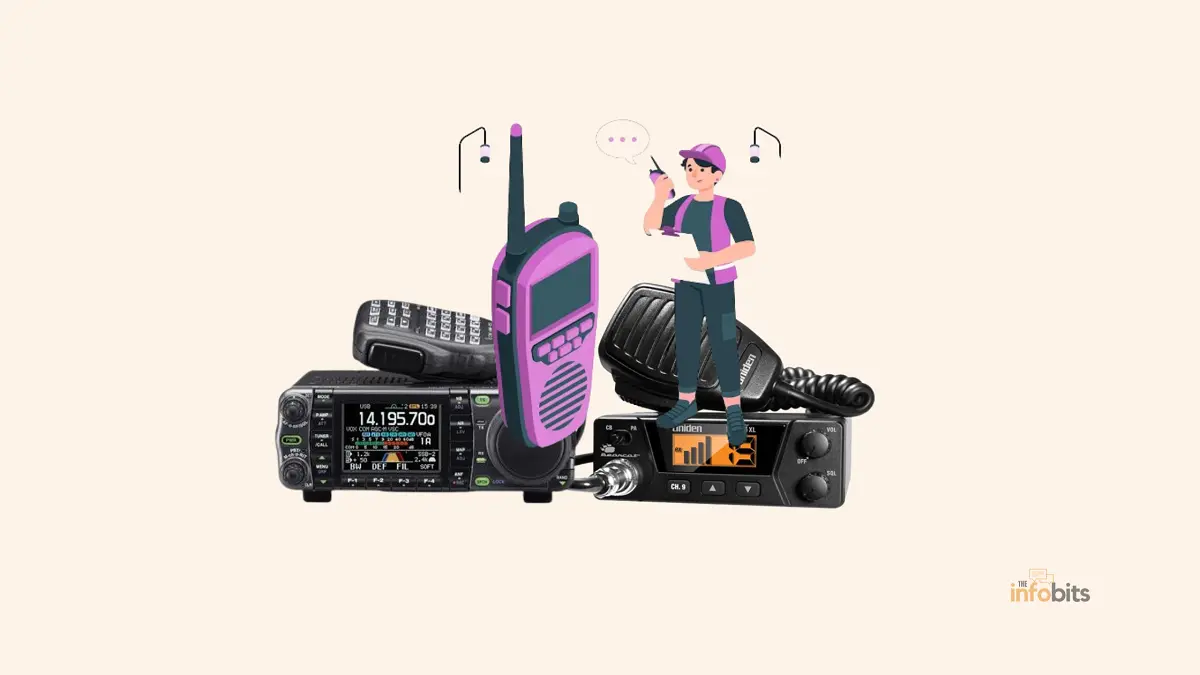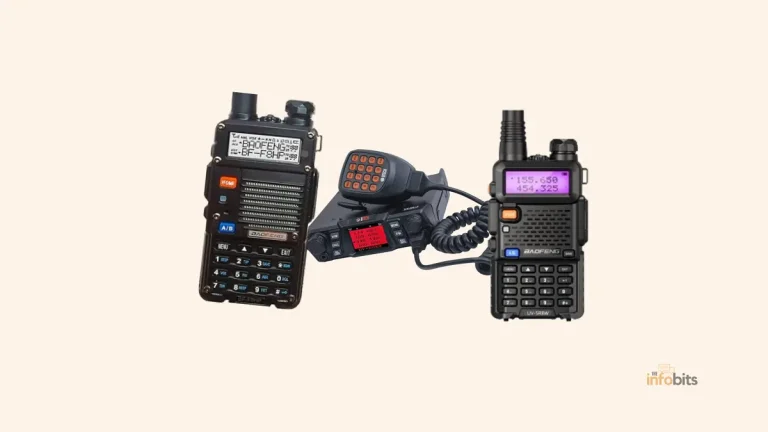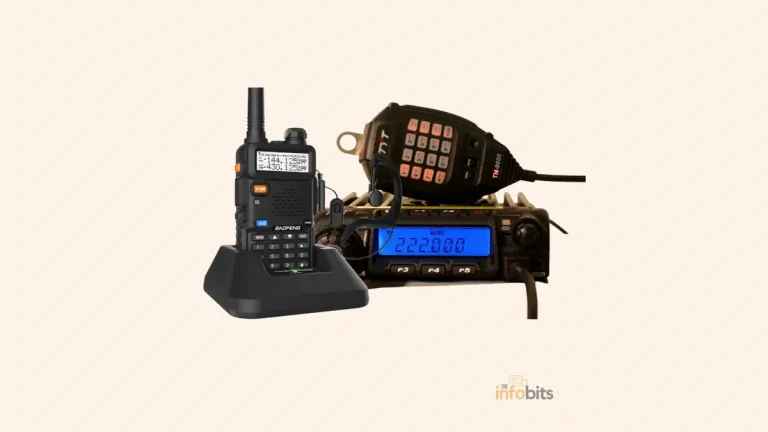Ham Radio vs CB Radio: Exploring the World of Communication
Ham radio and CB radio are two prominent modes of communication that have been used by both hobbyists and professionals for decades.
Before we go through the deep comparison of Ham radio vs CB radio, it is better to understand that both radios enable wireless communication, but they differ in several ways, including functionality, license requirements, and range capabilities.
Whether you’re a radio hobbyist, emergency responder, or outdoor enthusiast, knowing the distinctions between ham radio and CB radio will help you make an informed decision about which radio system is ideal for you.
In this post, we will look at the purpose, functioning, license, benefits, and disadvantages of both ham radio and CB radio, giving you vital information to help you make the proper selection.
1. Ham Radio vs CB Radio – Basics
Understanding the Basics of Ham Radio
Ham radio, often known as amateur radio, is a hobby and service that allows people to speak with one another over specific radio frequencies.
Unlike CB radio, which is generally used for short-range communication, amateur radio operators can communicate locally, nationally, and even globally.
One of the distinguishing features of ham radio is that operators can construct and design their equipment and antennas, as well as compete in contests and other events.
It’s like being a tech-savvy detective, putting together the ideal radio setup to communicate with other members across the world.
Exploring the Basics of CB Radio
CB Radio is an abbreviation for Citizens Band Radio. It’s a type of short-range communication that became popular in the 1970s and is commonly used by truckers, off-roaders, and others who wish to stay in touch across short distances.
CB radios operate on particular channels within the 27 MHz frequency band, with a maximum power output of four watts.
While they may not have the same long-distance capabilities as ham radios, CB radios are a practical method to remain in touch with other road warriors or engage in local community talk.
2. Purpose and Functionality of Ham Radio
Communication Capabilities of Ham Radio
Ham radio is all about variety in terms of communication.
With the appropriate equipment, operators may communicate by speaking, Morse code, digital modes, or even by bouncing signals off the moon or satellites. The options are limitless.
Whether conversing with a fellow ham operator across the nation, participating in emergency communications during a natural disaster, or exploring the realm of digital modes such as packet radio or slow-scan TV, ham radio provides a plethora of communication alternatives.
Applications and Uses of Ham Radio
The uses for Ham radios are as diverse as the people who utilize them.
Ham radio is an adaptable gadget that may provide crucial communication during crises or natural catastrophes when other kinds of communication are unreliable, as well as speaking with friends all over the world.
In addition to personal enjoyment, ham radio operators benefit the scientific community by participating in experiments, supporting satellite communications, and assisting in the development of new technology.
Furthermore, it’s an excellent chance to meet like-minded individuals and join a global community of radio fans.
3. Purpose and Functionality of CB Radio
Communication Capabilities of CB Radio
CB radio uses 40 channels in the 27 MHz frequency band. Although CB radios have a shorter range than ham radios, they may still travel many miles, depending on the terrain and equipment employed.
CB radios are frequently used for communication on the road, whether it’s communicating with other truckers about traffic conditions or forming a convoy for a fun trip.
It’s a simple and accessible method to keep in touch with people without the need for a license or substantial technological skills.
Applications and Uses of CB Radio
CB radios have found use in a variety of sectors and hobbies. It is still popular among truckers, off-roaders, and outdoor enthusiasts who want rapid and easy communication when traveling in a convoy or exploring rural locations.
CB radio has a long history in popular culture, from the well-known “Breaker, Breaker” slogan to the classic CB radio discussions shown in films such as “Smokey and the Bandit.”
It’s a fun and vintage mode of communication that still has appeal today.
4. Licensing and Regulations for Ham Radio Operators
Requirements for Obtaining a Ham Radio License
To become a licensed ham radio operator, you must pass an exam arranged by the Federal Communications Commission.
The test includes rules, operational procedures, and fundamental electronics theory.
There are three licensing levels: Technician, General, and Extra, with each providing extra frequencies and operating capabilities.
While the test may appear overwhelming, there are various tools available to help prospective operators prepare.
Many amateur radio organizations provide seminars and study groups, making the procedure more accessible to newbies.
Understanding the FCC Regulations for Ham Radio
The Federal Communications Commission oversees Ham Radio to guarantee that the radio spectrum is used efficiently and responsibly.
Operators must follow specific restrictions, including utilizing allocated frequencies, identifying themselves using call signs, and refraining from forbidden activities such as music broadcasting or commercial ham radio use.
However, within these guidelines, ham radio enthusiasts are allowed to explore, contribute to the community, and enjoy the pleasures of radio communication.
Ham radio is a hobby with limitless possibilities, connecting individuals from all walks of life via the airways, one conversation at a time.
5. Licensing and Regulations for CB Radio Users
Requirements for Operating a CB Radio
No license or formal training is required to use a CB radio. It’s as simple as taking a radio, plugging it in, and getting started. No expensive qualifications or examinations are required!
Understanding the FCC Regulations for CB Radio
The Federal Communications Commission (FCC) has created restrictions for CB radio use to ensure clear communication and eliminate interference.
These laws set restrictions on output power, channel utilization, and the types of antennas that can be used.
It is essential to familiarize oneself with these regulations to avoid any unintentional radio misbehavior and guarantee that everyone receives their fair share of airwaves.
6. Ham Radio vs CB Radio: Range and Coverage Comparison
Evaluating the Range and Coverage of Ham Radio
In a ham radio vs CB radio range comparison, ham radio enthusiasts frequently brag about their excellent range.
With the correct technology and settings, you may connect with people on different continents or even astronauts on the International Space Station. How about reaching for the stars?
Evaluating the Range and Coverage of CB Radio
While CB radio lacks the long-range capabilities of ham radio, it still provides enough coverage.
Depending on the topography and antenna configuration, you should be able to connect within a few kilometers.
It’s ideal for getting in contact with other road trippers or truckers nearby, but don’t expect to communicate with anybody on Mars.
7. Advantages and Disadvantages of Ham Radio
Advantages of Ham Radio
The flexibility provided by Ham Radio is one of its most significant advantages. To enhance range and clarity, experiment with various frequencies, modes, and antennas.
Furthermore, ham radio operators have a dynamic network of like-minded people who are always willing to communicate and share their experiences.
It’s like entering an elite club but without the annoying bouncer!
Disadvantages of Ham Radio
Despite the enjoyment, there are a few disadvantages to Ham radio. First, obtaining a ham radio license necessitates passing an exam.
Don’t worry, it’s not rocket science (unless you’re into it), but it does require some research.
Second, the equipment might be expensive, particularly if you want to push the limits of communication.
Finally, even if you have a diverse network, it might be difficult to locate someone to chat with late at night when the rest of the world is sleeping.
8. Advantages and Disadvantages of CB Radio
Advantages of CB Radio
CB radio offers a few distinct benefits.
First and foremost, it’s quite simple to use. There are no licenses or examinations required; simply pick up a radio and start conversing. It’s ideal for the impulsive talker in all of us.
Furthermore, CB radios are quite inexpensive, making them a viable alternative for informal talks or keeping things interesting during road trips.
Disadvantages of CB Radio
As convenient as it is, CB radio has its drawbacks.
Because of the restricted range, you won’t be able to communicate with people on the opposite side of the planet. CB radio is intended for local communications, so if you want flashy international chats, you may feel left out.
Furthermore, because there is no license requirement, you may encounter people with less-than-stellar radio manners, resulting in an entertaining but chaotic listening experience.
9. Conclusion
In conclusion, both ham radio and CB radio provide specific features and benefits for communication.
Ham radio, with its broad range, license requirements, and various uses, appeals to individuals looking for a more complex and diversified radio experience.
CB radio, on the other hand, offers a simpler and more accessible method of short-distance, casual communication.
Finally, the decision between ham radio and CB radio is based on your requirements, interests, and degree of dedication.
Understanding the distinctions highlighted in this article allows you to make an informed selection and go on an exciting path to wireless communication.
10. Frequently Asked Questions
1. Do I need a license to operate a CB radio?
CB Radio does not require a license to operate. It offers a more accessible solution for casual users who do not want to go through the licensing procedure.
2. Can I use a ham radio without a license?
No, a license is necessary to operate a Ham radio. The licensing process usually includes completing an exam that assesses your understanding of radio rules, operation procedures, and technical fundamentals.
3. What is the range difference between ham radio and CB radio?
The range of communication for Ham Radio can vary greatly based on frequency, power output, antenna height, and weather conditions. With the proper equipment and setup, Ham Radio may attain global communication capabilities. In contrast, CB radio has a restricted range, often up to a few miles, making it ideal for short-range local communication.
4. Can I communicate between a ham radio and a CB radio?
Ham Radio is well known for its vast emergency communication capabilities. During calamities or natural disasters, Ham Radio operators frequently offer critical communication lines when other communication infrastructure fails. They can set up communication networks and deliver essential information to emergency services and communities. While CB radio can be utilized for emergency communication in some cases, its range and capabilities are restricted when compared to Ham Radio.
5. What are the costs associated with Ham Radio and CB Radio?
The expenses of Ham Radio might vary based on the equipment and technologies you use. Ham Radio’s initial setup expenses might be greater owing to the requirement for specialized devices, antennas, and accessories. In addition, there may be yearly licensing costs. CB radio, on the other hand, is often more economical, with basic CB radios costing less and no licensing costs necessary. Additional fees may be incurred if you choose advanced features or extras.
Please share this article with your friends and relatives if you find it useful.
We also ask that you bookmark this page for future reference, as we are constantly updating our articles with new information.
Sign up for our free newsletter as well to receive fresh information immediately in your inbox and keep technically up to date.





